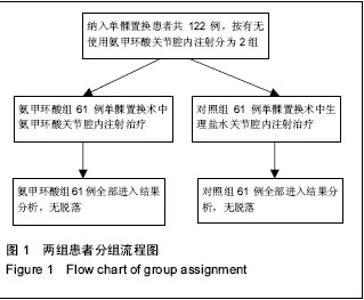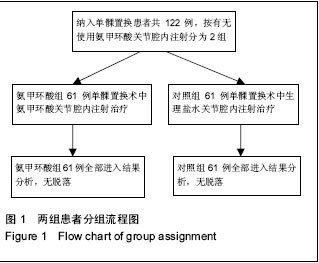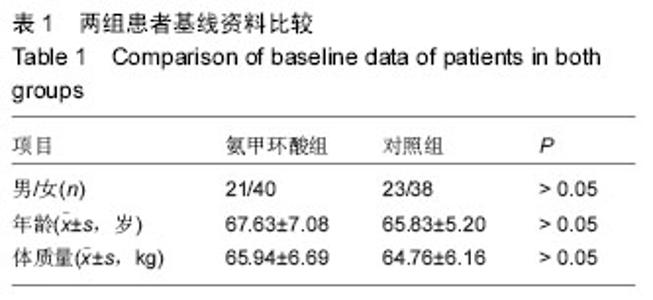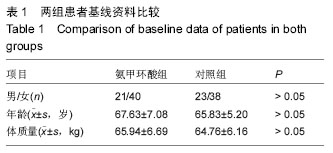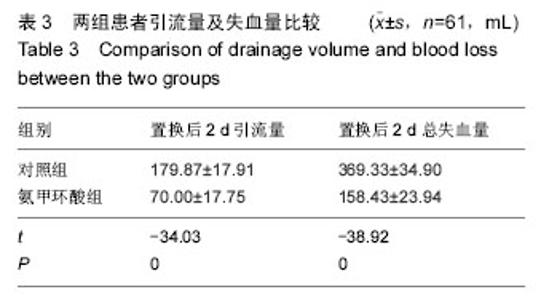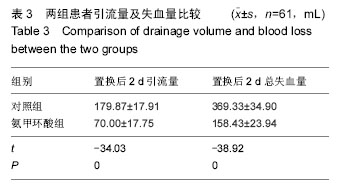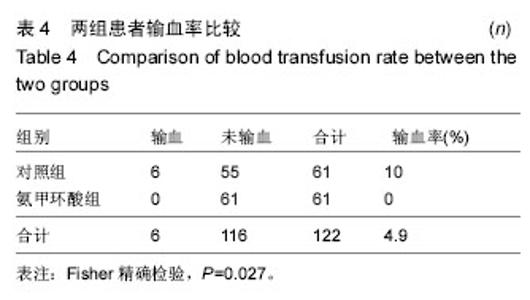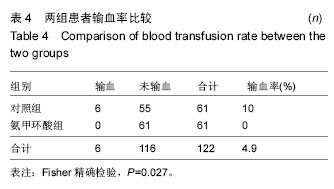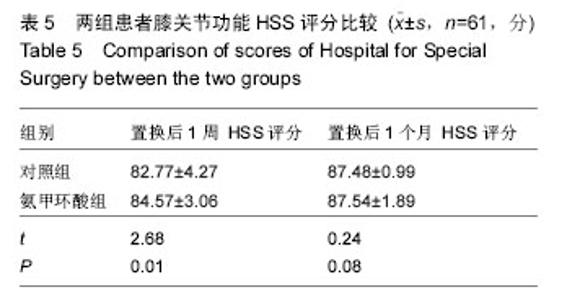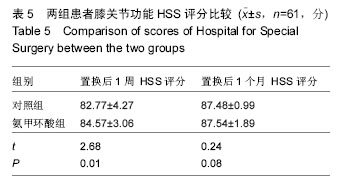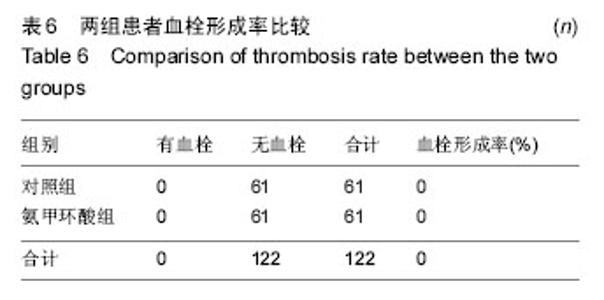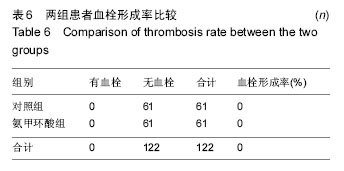Chinese Journal of Tissue Engineering Research ›› 2016, Vol. 20 ›› Issue (22): 3197-3204.doi: 10.3969/j.issn.2095-4344.2016.22.001
Effects of intraarticular tranexamic acid injection combined with 3-hour drainage tube occlusion postoperatively on blood loss in unicompartmental knee arthroplasty
Zeng Bing, Liu Gang, He Zhi-sheng, Zheng Lian-jie, Jing Feng-bo, Lv Hao
- Department of Orthopedics, the Second Affiliated Hospital of Dalian Medical University, Dalian 116027, Liaoning Province, China
-
Revised:2016-03-25Online:2016-05-27Published:2016-05-27 -
Contact:Liu Gang, Chief physician, Professor, Master’s supervisor, Department of Orthopedics, the Second Affiliated Hospital of Dalian Medical University, Dalian 116027, Liaoning Province, China -
About author:Zeng Bing, Studying for master’s degree, Department of Orthopedics, the Second Affiliated Hospital of Dalian Medical University, Dalian 116027, Liaoning Province, China
CLC Number:
Cite this article
Zeng Bing, Liu Gang, He Zhi-sheng, Zheng Lian-jie, Jing Feng-bo, Lv Hao. Effects of intraarticular tranexamic acid injection combined with 3-hour drainage tube occlusion postoperatively on blood loss in unicompartmental knee arthroplasty[J]. Chinese Journal of Tissue Engineering Research, 2016, 20(22): 3197-3204.
share this article
| [1] Kristensen PW, Holm HA, Varnum C.Up to 10-year follow-up of the Oxford medial partial knee arthroplasty--695 cases from a singleinstitution.J Arthroplasty. 2013;28(9 Supp1):195-198.[2] 周友龙,陈奇,康一凡,等. 小切口单髁置换术治疗膝关节内侧间室骨性关节炎的早期疗效观察[J].中国骨与关节损伤杂志, 2013,28(8):716-718.[3] Katsumata S,Nagashima M,Kato K. Changes in coagulation-fibrinolysis markerandneutrophil elastase following the use of tourniquet duringtotal knee arthroplastyand the influence ofneutrophil elastaseonthromboembolism.Acta Anaesthesiol Scand. 2005;49(4):510-516.[4] 尹俊萍,苗海敏,乔国勇,等.膝关节置换中应用骨水泥和止血带对凝血功能的影响[J].中国组织工程研究,2012, 16(44):8186-8190.[5] Vamvakas EC,Blajchman MA.Transfusion-related mortality: the ongoingrisksofallo geneicbloodtransfusion and theavailablestrategies for theirprevention.Blood.2009;113(15):3406-3417.[6] 尹建石,刘欣伟,赵东风,等.术中关节腔内注射氨甲环酸对TKA失血量的影响[J].中国骨与关节损伤杂志, 2015, 30(2): 205-206.[7] 郑萍,翁绳健,吴立忠,等.关节腔内注射氨甲环酸对单侧人工全膝关节置换术后引流量的影响[J]. 中国骨与关节损伤杂志,2015,30(4):357-359.[8] Ishida K,Tsumura N,Kitagawa A,et al. Intra-articular injection of tranexamic acid reduces not only blood loss but also knee joint swelling after total knee arthroplasty. Int Orthop.2011;35(11):1639-1645.[9] 马金辉,孙伟,高福强,等.关节腔注射氨甲环酸单侧全膝关节置换者的失血量及肢体周径变化:随机对照[J].中国组织工程研究,2014,81(35):5577-5582.[10] 柴星宇,苏长征,庞涛, 等.全膝关节置换后静脉与局部应用氨甲环酸对失血量的影响[J].中国组织工程研究, 2015, 19(35):5604-5609.[11] 侯振扬,苏长征,庞涛,等.初次单侧骨水泥型全膝关节置换:氨甲环酸使用方式对失血量的影响[J].中国组织工程研究, 2015,19(9):1329-1334.[12] Jain RK,Neville LT,Ezzet KA,et al. Two Year Follow-up of the Preservation Unicompartmental Knee Implant. HSS J. 2011;7(2):125-129.[13] Gross JB. Estimating allowable blood loss:corrected for dilution. Anesthesiolog.1983;58(3):277-280.[14] Nadler SB,Hidalgo JH,Bloch T. Prediction of blood volume in normal human adults. Surgery. 1962;51(2): 224-232.[15] Sehat KR,Evans RL,Newman JH. Hidden blood loss following hip and knee arthroplasty correct management of blood loss should take hidden loss into account.J Bone Joint Surg Br. 2004;86(4):561-565.[16] MacGillivray RG, Tarabichi SB, Hawari MF, et al. TranexamicAcid to Reduce Blood Loss After Bilateral Total KneeArthroplasty : A Prospective, Randomized Double Blind Study.J Arthroplasty. 2011;26(1):24-28.[17] 吕厚山.现代人工关节外科学[M].北京:人民卫生出版社, 2006:69-78.[18] Tan J, Chen H, Liu Q, et al. A meta-analysis of the effectivenessand safety of using tranexamic acid in primary unilateral totalknee arthroplasty. J Surg Res.2013;184(2): 880-887.[19] Petaja J, Myllynen P, Myllyla G, et al. Fibrinolysis afterapplication of a pneumatic tourniquet. Acta Chir Scand. 1987;153(11-12):647-651.[20] Klenerman L, Chakrabarti R, Mackie I, et al. Changes inhaemostatic system after application of a tourniquet. Lancet.1977;1(8019):970-972.[21] Reikeras O,Clementsen T. Time course of thrombosis and fibrinolysis in total knee arthroplasty with tourniquet application. Local versus systemicactivations. J Thromb Thrombolysis. 2009; 28(4):425-428.[22] McCormack PL. Tranexamic acid:a review of its use in the treatment of hyperfibrinolysis. Drugs. 2012;72(5): 585-617.[23] 刘江俊,刘忠强,田少奇,等.氨甲环酸对减少单侧全膝关节置换术后出血的疗效观察[J].中国矫形外科杂志, 2014, 22(23): 2144-2148.[24] McCormack PL. Tranexamic acid: a review of its use in thetreatment of hyperfibrinolysis. Drugs. 2012;72(5): 585-617.[25] 闵鹏,彭银虓,胡江海,等.氨甲环酸对单侧全膝关节置换失血量的影响及安全性评价[J].中国组织工程研究, 2015, 19(17):2655-2660.[26] 王荣,田少奇,哈承志,等.氨甲环酸减少双侧全膝关节置换失血量的有效性及安全性评价[J].中国组织工程研究, 2015,19(22):3451-3456.[27] 曹万军,朱绍灵,刘显东,等.氨甲环酸用于全膝关节置换降低失血量的有效性及安全性[J].中国组织工程研究,2015, 19(31):4944-4948.[28] Wong J,Abrishami A,El Beheiry H,et al. Topical application of tranexamic acid reduces postoperative blood loss in total knee arthroplasty: a randomized, controlled trial. J Bone Joint Surg Am. 2010;92(15): 2503-2513.[29] Akizuki S,Yasukawa Y,Takizawa T. A new method of hemostasis for cementless total knee arthroplasty. Bull Hosp Jt Dis.1997;56(4):222-224.[30] Maniar RN, Kumar G, Singhi T, et al. Most effective regimen oftranexamic acid in knee arthroplasty: a prospective randomizedcontrolled study in 240 patients. Clin Orthop Relat Res. 2012;470(9): 2605-2612.[31] Tanaka N, Sakahashi H, Sato E, et al. Timing of theadministration of tranexamic acid for maximum reduction inblood loss in arthroplasty of the knee. J Bone Joint Surg Br.2001;83(5):702-705.[32] Kiely N,Hockings M,Gambhir A. Does temporary clamping of drains following knee arthroplasty reduce bloodloss? A randomisedcontrolled trial. Knee. 2001; 8:325-327.[33] Larsson J,Lewis DH,Liljedahl SO,et al. Early biochemical and hemodynamic changes after operationin a bloodless field.Eur Surg Res.1977;9(5): 311-20.[34] Wong J,Abrishami A,El Beheiry H,et al. Topical application of tranexamic acid reduces postoperative blood loss in total knee arthroplasty: a randomized, controlled trial.J Bone Joint Surg Am.2010;92(15): 2503-2513.[35] 计忠伟,包倪荣,赵建宁,等.关节腔注射氨甲环酸对全膝关节置换术后疗效影响的Meta分析[J].中国骨与关节损伤杂志,2015,3(02):164-168.[36] 胡洪新,林海滨. 氨甲环酸在髋膝关节置换术中应用的研究进展[J].中华关节外科杂志(电子版),2015,9(4): 532-535.[37] Akizuki S,Yasukawa Y,Takizawa T.A new method of hemostasis for cementless total knee arthroplasty. 1997;56(4):222-224.[38] 李飞雄,王智勇,张志强.全膝关节置换中应用氨甲环酸有效性及安全性的Meta分析[J].中国组织工程研究, 2015, 19(9):1463-1469.[39] 武婷,文其祥. 氨甲环酸与抑肽酶对血液保护功能的对比研究[J].中国体外循环杂志,2005,3(1):10-13.[40] Poeran J, Rasul R, Suzuki S, et al. Tranexamic acid use andpostoperative outcomes in patients undergoing total hip or kneearthroplasty in the United States: retrospective analysis ofeffectiveness and safety. BMJ. 2014;349:g4829.[41] Dahuja A, Dahuja G, Jaswal V, et al. A Prospective Study on Role of Tranexamic Acid in Reducing Postoperative Blood Loss in Total Knee Arthroplasty and Its Effect on Coagulation Profile. J Arthroplasty. 2014;29(4):733-735.[42] Yang ZG,Chen WP,Wu LD.Effectiveness and safety of tranexamic acid inreducing blood loss in total knee arthroplasty: a meta-analysis.J Bone Joint Surg Am.2012;94(13):1153-1159.[43] Cid J,Lozano M. Tranexamic acid reduces allogeneic red cel transfusions in patients undergoing total knee arthroplasty:results of a meta-analysis of randomized controlled trials.Transfusion.2005;45:1302-1307.[44] 李阳,张卫国,李洪敬.全膝关节置换关节内应用氨甲环酸的临床对比研究[J].医学与哲学(B),2013,34(9):27-30. |
| [1] | Zhang Tongtong, Wang Zhonghua, Wen Jie, Song Yuxin, Liu Lin. Application of three-dimensional printing model in surgical resection and reconstruction of cervical tumor [J]. Chinese Journal of Tissue Engineering Research, 2021, 25(9): 1335-1339. |
| [2] | Zhang Yu, Tian Shaoqi, Zeng Guobo, Hu Chuan. Risk factors for myocardial infarction following primary total joint arthroplasty [J]. Chinese Journal of Tissue Engineering Research, 2021, 25(9): 1340-1345. |
| [3] | Li Dadi, Zhu Liang, Zheng Li, Zhao Fengchao. Correlation of total knee arthroplasty efficacy with satisfaction and personality characteristics [J]. Chinese Journal of Tissue Engineering Research, 2021, 25(9): 1346-1350. |
| [4] | Wei Wei, Li Jian, Huang Linhai, Lan Mindong, Lu Xianwei, Huang Shaodong. Factors affecting fall fear in the first movement of elderly patients after total knee or hip arthroplasty [J]. Chinese Journal of Tissue Engineering Research, 2021, 25(9): 1351-1355. |
| [5] | Wang Jinjun, Deng Zengfa, Liu Kang, He Zhiyong, Yu Xinping, Liang Jianji, Li Chen, Guo Zhouyang. Hemostatic effect and safety of intravenous drip of tranexamic acid combined with topical application of cocktail containing tranexamic acid in total knee arthroplasty [J]. Chinese Journal of Tissue Engineering Research, 2021, 25(9): 1356-1361. |
| [6] | Xiao Guoqing, Liu Xuanze, Yan Yuhao, Zhong Xihong. Influencing factors of knee flexion limitation after total knee arthroplasty with posterior stabilized prostheses [J]. Chinese Journal of Tissue Engineering Research, 2021, 25(9): 1362-1367. |
| [7] | Huang Zexiao, Yang Mei, Lin Shiwei, He Heyu. Correlation between the level of serum n-3 polyunsaturated fatty acids and quadriceps weakness in the early stage after total knee arthroplasty [J]. Chinese Journal of Tissue Engineering Research, 2021, 25(9): 1375-1380. |
| [8] | Zhang Chong, Liu Zhiang, Yao Shuaihui, Gao Junsheng, Jiang Yan, Zhang Lu. Safety and effectiveness of topical application of tranexamic acid to reduce drainage of elderly femoral neck fractures after total hip arthroplasty [J]. Chinese Journal of Tissue Engineering Research, 2021, 25(9): 1381-1386. |
| [9] | Yuan Jiawei, Zhang Haitao, Jie Ke, Cao Houran, Zeng Yirong. Underlying targets and mechanism of Taohong Siwu Decoction in prosthetic joint infection on network pharmacology [J]. Chinese Journal of Tissue Engineering Research, 2021, 25(9): 1428-1433. |
| [10] | Chen Junming, Yue Chen, He Peilin, Zhang Juntao, Sun Moyuan, Liu Youwen. Hip arthroplasty versus proximal femoral nail antirotation for intertrochanteric fractures in older adults: a meta-analysis [J]. Chinese Journal of Tissue Engineering Research, 2021, 25(9): 1452-1457. |
| [11] | Chen Jinping, Li Kui, Chen Qian, Guo Haoran, Zhang Yingbo, Wei Peng. Meta-analysis of the efficacy and safety of tranexamic acid in open spinal surgery [J]. Chinese Journal of Tissue Engineering Research, 2021, 25(9): 1458-1464. |
| [12] | Zeng Yanhua, Hao Yanlei. In vitro culture and purification of Schwann cells: a systematic review [J]. Chinese Journal of Tissue Engineering Research, 2021, 25(7): 1135-1141. |
| [13] | Yuan Jun, Yang Jiafu. Hemostatic effect of topical tranexamic acid infiltration in cementless total knee arthroplasty [J]. Chinese Journal of Tissue Engineering Research, 2021, 25(6): 873-877. |
| [14] | Kong Lingbao, Lü Xin. Effect of implant selection and approach on support in the operation of posterolateral tibial plateau fractures [J]. Chinese Journal of Tissue Engineering Research, 2021, 25(6): 942-947. |
| [15] | Huang Dengcheng, Wang Zhike, Cao Xuewei. Intravenous, topical tranexamic acid alone or their combination in total knee arthroplasty: a meta-analysis of randomized controlled trials [J]. Chinese Journal of Tissue Engineering Research, 2021, 25(6): 948-956. |
| Viewed | ||||||
|
Full text |
|
|||||
|
Abstract |
|
|||||
